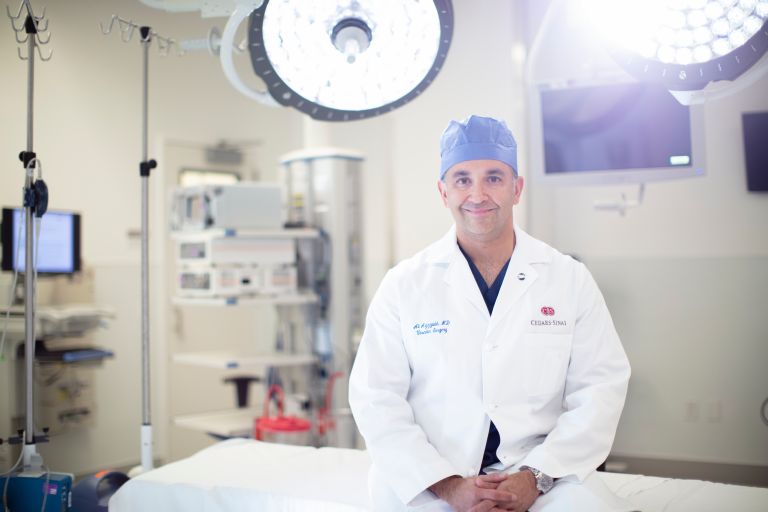As it turned out, Inman was right. Something was very wrong.
After being evaluated at his local community hospital in Long Beach, Inman was transferred by helicopter to the experts at Cedars-Sinai. It was there that he was quickly diagnosed with an aortic dissection — a tear that develops along the inner layer of the aorta, the artery that pumps blood out of the heart to the rest of the body. Aortic dissection is a medical emergency that requires immediate surgical intervention.
“James’s decision to call 911 absolutely saved his life,” said Ali Azizzadeh, MD, one of Inman’s surgeons and director of Vascular Surgery at the Smidt Heart Institute at Cedars-Sinai. “The death rate for aortic dissections increases 1% every hour the diagnosis and surgical repair are delayed.”
Today, on International Aortic Dissection Day, Inman, Azizzadeh and an international group of patients and medical providers are urging the public to learn more about aortic dissections, including symptoms and risk factors, while also underscoring the importance of seeking urgent medical attention if symptoms-such as severe chest, back or abdominal pain, shortness of breath, pain in the arms or legs, weakness, heavy sweating or anxiety-arise.
Many people with aortic dissections are misdiagnosed because the symptoms can mimic a heart attack. Azizzadeh says it’s imperative that if you have symptoms of a heart attack, but were found not to have one, you should ask to be screened for an aortic dissection.
“This is especially important if a patient has a family history of thoracic aortic aneurysms or dissections,” said Azizzadeh. “Or, if a patient has features of a genetic syndrome that predisposes them to an aortic aneurysm or dissection.”
Only three types of imaging studies can identify an aortic dissection, said Azizzadeh, including a CT, MRI or transesophageal echocardiogram. A chest X-ray and an electrocardiogram cannot rule them out.
Risk factors for the condition include aneurysms, a personal or family history of thoracic disease, bicuspid aortic valve disease and certain genetic syndromes including Marfan syndrome, Loeys-Dietz syndrome, vascular Ehlers-Danlos syndrome and Turner syndrome.
“If you have a bicuspid aortic valve, which is two leaflets instead of the typical three, you need to be monitored for thoracic aortic disease,” said Azizzadeh. “It’s also important to understand that several lifestyle and trauma-related conditions can trigger aortic dissections.”
These triggers can be caused by extreme straining associated with body building, illicit drug abuse, poorly controlled high blood pressure or by discontinuing necessary blood pressure medications. Another rare but possible trigger for aortic dissection includes pregnancy, especially for women with aortic aneurysms and connective tissue disorders.
“These women are at higher risk of aortic dissection during late pregnancy and delivery,” said Azizzadeh. “They should be carefully monitored by a cardiovascular specialist.”
To heal Inman’s severe aortic dissection, he underwent several procedures over the course of eight months, including emergency open-heart surgery, a debranching procedure and most recently, Thoracic Endovascular Aneurysm Repair, or TEVAR– the final step to repair his aorta.
Today, Inman is preparing to return to work as a maintenance technician, a relieving next step after months of procedures and recovery.
“Take your health and symptoms seriously,” said Inman, when asked what he wants others to know about aortic dissections. “I don’t know where I’d be if I waited a moment later to call 911. I’m so lucky my incredible care team diagnosed the issue so quickly and healed my bleeding heart.”
Read more on the Cedars-Sinai blog: Faces of Cedars-Sinai: Vascular Surgeon Ali Azizzadeh
Original post https://alertarticles.info



